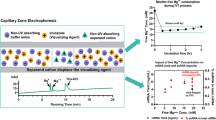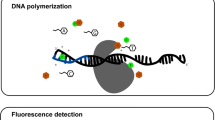Abstract
A self-contained polymerase chain reaction (PCR) platform with miniaturized power-system is introduced. It is powered by portable lithium batteries and integrated continuous-flow PCR amplification platform. Generally speaking, traditional commercial thermal cyclers rely on external electric supply and thus they are too big in instrument size. This prevents real-timely and field testing during PCR diagnosis. The authors are introducing a continuous-flow 3D spiral microreactor for DNA amplifications and high-resolution multiplexed targets’ detection by utilizing the polyvinyl chloride (PVC) tubing-polymer to fabricate the microreactor for the first time. The whole setup (that can all be placed in one hand) includes (a) the thermo-cycled control (5.5 cm width, 10 cm length and 11 cm height), (b) the passive continuous-flow control, and (c) the trapezoidal PCR microreactor. The PCR platform can work for 4.5 h continuously. With minimal accessories and operations, the total cost of the self-contained PCR machinery is <20 $, much lower than the mainstream of commercial PCR machinery. By waiving external electric supply, this miniaturized PCR platform is applied to amplify the typical DNA fragments of plasma isolated hepatitis B virus (HBV), influenza virus (H7N9avian influenza) bacterium (Escherichia coli) plasmid and multiplexed targets. The efficiency of the method is 70% of that of commercial thermal cycler (CFX Connect, Bio Rad). The DNA of H7N9avian influenza can be detected in concentrations as low as 103 copies per μL.

By utilizing the polyvinyl chloride (PVC) tubing-polymer to fabricate the microchip for the first time, this paper introduces a 3D spiral microreactor with a miniaturized power-system supplied by portable AA-batteries, applied in DNA amplifications and high-resolution multiplexed targets’ detection. In this microdevice, we made the machinery portable by waiving the external plugs, which solved the problem of traditional commercial thermal cyclers about large volume and expensive price.





Similar content being viewed by others
References
Fernandez-Carballo BL, McGuiness I, McBeth C, Kalashnikov M, Borros S, Sharon A, Sauer-Budge AF (2016) Low-cost, real-time, continuous flow PCR system for pathogen detection. Biomed Microdevices 18(2):34
Ragsdale V, Li H, Sant H, Ameel T, Gale BK (2016) A disposable, continuous-flow polymerase chain reaction device: design, fabrication and evaluation. Biomed Microdevices 18(4):62
Hashimoto M, Chen PC, Mitchell MW, Nikitopoulos DE, Soper SA, Murphy MC (2004) Rapid PCR in a continuous flow device. Lab Chip 4(6):638–645
Chandrasekaran A, Packirisamy M (2010) Integrated micro-total analysis system (uTAS) for biophotonic enzymatic detections. Proceedings of SPIE - The International Society for Optical Engineering 7555
Hilbich DD, Khosla A, Gray BL, Shannon L (2011) Bidirectional magnetic microactuators for uTAS. Proc SPIE 7929(1):225–229
Miribelcatalà P, Samitiermartí J (2011) Combined impedance and dielectrophoresis portable device for point-of-care analysis. Proceedings of SPIE - The International Society for Optical Engineering 8068(2)
Bustin S (2002) Quantification of mRNA using real-time reverse transcription PCR (RT-PCR): trends and problems. J Mol Endocrinol 29(1):23–39
Bustin SA, Benes V, Nolan T, Pfaffl MW (2005) Quantitative real-time RT-PCR--a perspective. J Mol Endocrinol 34(3):597–601
Takeuchi K, Choi YL, Soda M, Inamura K, Togashi Y, Hatano S, Enomoto M, Takada S, Yamashita Y, Satoh Y, Okumura S, Nakagawa K, Ishikawa Y, Mano H (2008) Multiplex reverse transcription-PCR screening for EML4-ALK fusion transcripts. Clin Cancer Res 14(20):6618–6624
Lee NY (2018) A review on microscale polymerase chain reaction based methods in molecular diagnosis, and future prospects for the fabrication of fully integrated portable biomedical devices. Microchim Acta 185(6):285
Moschou D, Vourdas N, Kokkoris G, Papadakis G, Parthenios J, Chatzandroulis S, Tserepi A (2014) All-plastic, low-power, disposable, continuous-flow PCR chip with integrated microheaters for rapid DNA amplification. Sensors Actuators B Chem 199(4):470–478
Tachibana H, Saito M, Shibuya S, Tsuji K, Miyagawa N, Yamanaka K, Tamiya E (2015) On-chip quantitative detection of pathogen genes by autonomous microfluidic PCR platform. Biosens Bioelectron 74:725–730
Tachibana H, Saito M, Tsuji K, Yamanaka K, Hoa LQ, Tamiya E (2015) Self-propelled continuous-flow PCR in capillary-driven microfluidic device: microfluidic behavior and DNA amplification. Sensors Actuators B Chem 206:303–310
Wu W, Lee NY (2011) Three-dimensional on-chip continuous-flow polymerase chain reaction employing a single heater. Anal Bioanal Chem 400(7):2053–2060
Wu W, Trinh KT, Lee NY (2012) Hand-held syringe as a portable plastic pump for on-chip continuous-flow PCR: miniaturization of sample injection device. Analyst 137(4):983–990
Wu W, Trinh KTL, Zhang Y, Yoon Lee N (2015) Portable plastic syringe as a self-actuated pump for long-distance uniform delivery of liquid inside a microchannel and its application for flow-through polymerase chain reaction on chip. RSC Adv 5(16):12071–12077
Trinh KTL, Lee NY (2017) A portable microreactor with minimal accessories for polymerase chain reaction: application to the determination of foodborne pathogens. Microchim Acta 184(11):4225–4233
Kopp MU, Mello AJD, Manz A (1998) Chemical amplification: continuous-flow PCR on a Chip. Science 280(5366):1046–1048
Jiang X, Shao N, Jing W, Tao S, Liu S, Sui G (2014) Microfluidic chip integrating high throughput continuous-flow PCR and DNA hybridization for bacteria analysis. Talanta 122:246–250
Reif-Acherman S (2012) The contributions of Henri victor Regnault in the context of organic chemistry of the first half of the nineteenth century. Química Nova 35(2):438–443
Krongauz VV, Ling MTK, O'Connell J (2015) Revisiting analysis of phthalate plasticizers concentration in poly(vinyl chloride). J Vinyl Addit Technol 21(3):197–204
Hong HT, Wu W, Lee NY (2013) Ethanol and UV-assisted instantaneous bonding of PMMA assemblies and tuning in bonding reversibility. Sensors Actuators B Chem 181(5):955–962
Li X, Wu W, Manz A (2017) Thermal gradient for fluorometric optimization of droplet PCR in virtual reaction chambers. Microchim Acta 184(9):3433–3439
Wu W, Lee NY (2013) Two-layer microdevice for parallel flow-through PCRs employing plastic syringes for semi-automated sample injection and a single heater for amplification: toward process simplification and system miniaturization. Sensors Actuators B Chem 181:756–765
Wu W, Manz A (2015) Rapid manufacture of modifiable 2.5-dimensional (2.5D) microstructures for capillary force-driven fluidic velocity control. RSC Adv 5(87):70737–70742
Trinh KTL, Wu W, Lee NY (2014) Bent polydimethylsiloxane–polycarbonate hybrid microdevice for on-chip flow-through polymerase chain reaction employing a single heater. Microchim Acta 181(13–14):1697–1705
Wu W, Kang KT, Lee NY (2011) Bubble-free on-chip continuous-flow polymerase chain reaction: concept and application. Analyst 136(11):2287–2293
Wu W, Loan KT, Lee NY (2012) Flow-through PCR on a 3D qiandu-shaped polydimethylsiloxane (PDMS) microdevice employing a single heater: toward microscale multiplex PCR. Analyst 137(9):2069–2076
Zhang W, Li N, Koga D, Zhang Y, Zeng H, Nakajima H, Lin J M, Uchiyama K (2018) Inkjet printing based droplet generation for integrated on-line digital PCR. Anal Chem
Allen RC, Rogelj S, Cordova SE, Kieft TL (2006) An immuno-PCR method for detecting bacillus thuringiensis Cry1Ac toxin. J Immunol Methods 308(1–2):109–115
Trinh KTL, Wu W, Lee NY (2017) Fabrication of a 3D Teflon microdevice for energy free homogeneous liquid flow inside a long microchannel and its application to continuous-flow PCR. RSC Adv 7(18):10624–10630
Trinh KTL, Wu W, Lee NY (2014) Planar poly(dimethylsiloxane) (PDMS)–glass hybrid microdevice for a flow-through polymerase chain reaction (PCR) employing a single heater assisted by an intermediate metal alloy layer for temperature gradient formation. Sensors Actuators B Chem 190:177–184
Yin W, Badr AE, Mychaskiw G, Zhang JH (2002) Down regulation of COX-2 is involved in hyperbaric oxygen treatment in a rat transient focal cerebral ischemia model. Brain Res 926(1):165–171
Cong L, Fu S, Zhang J, Zhao J, Zhang Y (2018) Effects of atorvastatin on porcine aqueous humour outflow and trabecular meshwork cells. Exp Ther Med 15(1):210–216
Park J, Park H (2017) Thermal cycling characteristics of a 3D-printed serpentine microchannel for DNA amplification by polymerase chain reaction. Sensors Actuators A Phys 268
Wu W, Trinh KT, Lee NY (2015) Flow-through polymerase chain reaction inside a seamless 3D helical microreactor fabricated utilizing a silicone tube and a paraffin mold. Analyst 140(5):1416–1420
Author information
Authors and Affiliations
Corresponding author
Ethics declarations
The author(s) declare that they have no competing interests.
Rights and permissions
About this article
Cite this article
Shi, B., He, G. & Wu, W. A PCR microreactor machinery with passive micropump and battery-powered heater for thermo-cycled amplifications of clinical-level and multiplexed DNA targets. Microchim Acta 185, 467 (2018). https://doi.org/10.1007/s00604-018-3007-z
Received:
Accepted:
Published:
DOI: https://doi.org/10.1007/s00604-018-3007-z




